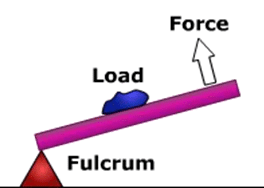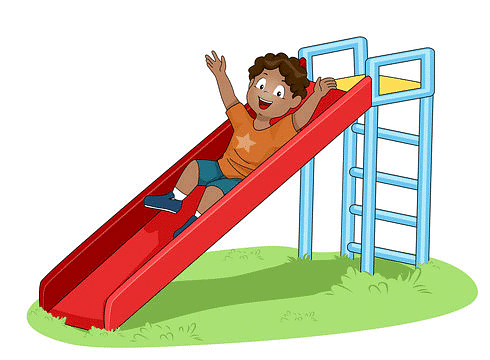Class 5 Exam > Class 5 Notes > Science Class 5 > Detailed Notes: Force & Simple Machines (Part 2)
Force and Simple Machines (Part 2) Class 5 Notes Science
Machines
Tools make our work easier by reducing the force that needs to be applied to get the work done. These tools are known as machines.
- Machines help us to do work easily and with less effort.
- Machines help us to do work in less time.
- Machines make our life easy and comfortable.

Machines may be simple or complex

- Simple machines are tools that have very simple structure and that make our work easier and faster.
- Complex machines consist of two or more simple machines that work together.
Types of Simple Machines

1. Lever
A lever consists of a rod free to move about a fixed point. It consists of three parts – fulcrum, load and effort.
- Fulcrum is the fixed point around which the lever moves.
- Load is the object on which work is being done.
- Effort is the force applied on the lever.
Depending on the position of the fulcrum, load, and effort, there are three types of levers.
- Class 1 Lever: In class 1 levers, the fulcrum is between the load and the effort. A pair of scissors see-saw, crowbar and plier are examples of first-class levers.

- Class 2 Lever: In class 2 levers, the load is between the fulcrum and effort. A bottle opener, a wheelbarrow, and a nut cracker are levers of class 2. A lever of class 2 always increases force.

- Class 3 Lever: In class 3 levers, the effort is between the fulcrum and load. Stapler, tweezers fishing rods and tongs are examples of third-class levers. This class of levers is used to decrease force to carry out delicate work.

2. Wheel and Axle
- The wheel is one of the most important inventions by humans.
- A wheel and axle consists of a wheel attached to a rod called an axle.
- When the axle is turned, the wheel also moves.
- The steering wheel of a car, screwdriver, sewing machine and doorknob are examples of wheel and axle.

There are two basic ways a wheel and axle can work together to help move things.
- The force is applied to the wheel
- The force is applied to the axle.
3. Inclined Plane
- An inclined plane is simply a slope with one end higher than the other.
- Less effort is needed to move an object up through an inclined plane as compared to lifting it up straight.
- A plank of wood is often used as an inclined plane to load heavy things on trucks.
- An inclined plane makes it easier to push up a load.
- Ramp, staircase, slide and roads in hilly regions are examples of inclined planes.

4. Wedge
- When two inclined planes are joined back to back in the shape of V, it forms a wedge.
- It can also be seen as an object with at least one slanting side ending in a sharp edge.
- A nail, fork, knife and an axe are examples of wedge.

5. Screw
- A screw looks like a nail with grooves cut in it.
- It has winding edge called thread.
- To insert it into wood, it has to be screwed in by turning it round and round with a screwdriver.
- It helps to hold things tightly.
- It takes less force to insert a screw in wood than a nail.
- Therefore, a screw increases force.
- Screw jack, drilling machine and nut bolts are examples of screw.

6. Pulley
A pulley is a wheel with a grooved rim so that a rope or chain can run around it. A pulley changes the direction of force applied. A pulley can be of two types – fixed pulley and movable pulley.
- Fixed pulley: In a fixed pulley, the axle is fixed to a support. It is used for drawing water from a well and raising a flag to the top of a flagpole.

- Movable pulley: Movable pulley is used in combination with a fixed pulley. It is used to lift heavy loads.

Safety Habits While Using Simple Machines
Machines are helpful to us. However, they should be handled with care.

- The moving parts of pulleys and levers can cause serious injuries. They should be used with care.
- Do not go near places where heavy loads are being lifted by pulleys.
- Make sure that the rope is in good condition before using a pulley. The machines should be well lubricated.
- Sharp edges of knives, scissors axes are dangerous. Handle them with care.
- Never wave around your hand while using a pair of scissors. You could hurt someone around you.
- When carrying sharp and pointed tools like knife, position the pointed edge downward.
- Hold the sharp objects away from your body.
- Always hold the handles of sharp objects.
- Sharp pointed tools should be stored in a tool box.
- Make sure that a hoe or axe is never leaning against an open door or on uneven floor. They could fall over, or someone could trip on them.
The document Force and Simple Machines (Part 2) Class 5 Notes Science is a part of the Class 5 Course Science Class 5.
All you need of Class 5 at this link: Class 5
|
42 videos|230 docs|45 tests
|
FAQs on Force and Simple Machines (Part 2) Class 5 Notes Science
| 1. What are the six types of simple machines? |  |
Ans. The six types of simple machines are the lever, wheel and axle, pulley, inclined plane, wedge, and screw. Each type helps to make work easier by changing the direction or magnitude of force applied.
| 2. How do simple machines help in reducing effort? |  |
Ans. Simple machines reduce effort by allowing a smaller input force to be used to accomplish the same amount of work. They achieve this by spreading the work over a longer distance or changing the direction of force.
| 3. What safety habits should be followed while using simple machines? |  |
Ans. Some important safety habits include wearing appropriate personal protective equipment (PPE), ensuring that machines are well-maintained, keeping hands and loose clothing away from moving parts, and following the manufacturer's instructions for use.
| 4. Can you give an example of how a lever works? |  |
Ans. A lever works by using a fulcrum to balance the load and effort. For example, when using a seesaw, if one person weighs more, they will need to sit farther from the fulcrum to balance the system, demonstrating how levers can amplify force.
| 5. How do inclined planes make work easier? |  |
Ans. Inclined planes make work easier by allowing objects to be raised over a height with less force. Instead of lifting an object straight up, you can push it up the slope, which requires less effort due to the longer distance over which the force is applied.
Related Searches

















